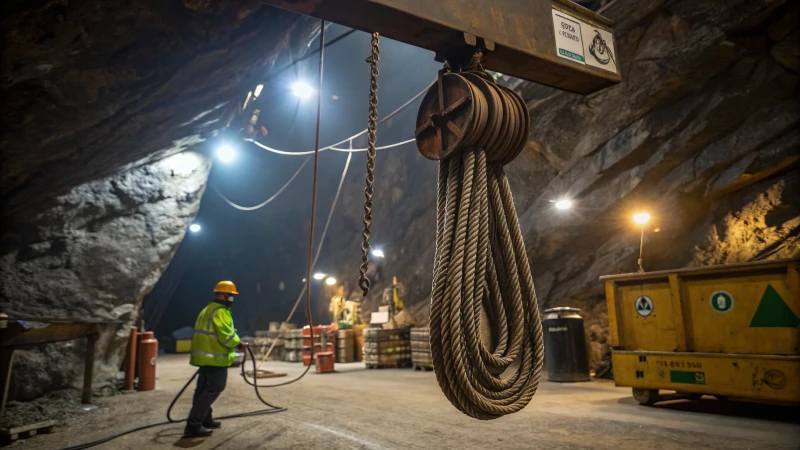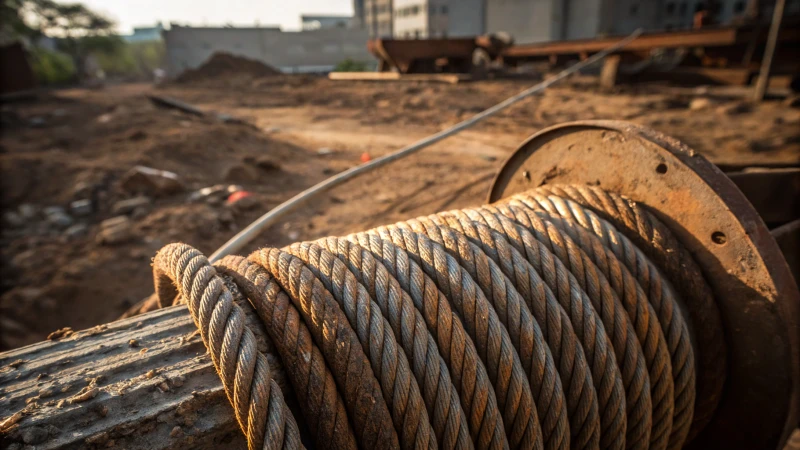
Ever wonder what keeps those giant mining machines running smoothly? It's all about the steel wire ropes, my friend!
In mining, steel wire ropes must meet environmental regulations like RoHS and REACH. These rules ensure ropes are made from eco-friendly materials, reducing hazardous substances and environmental impact throughout their lifecycle.
Thinking back to my first time on a mining site, I remember being amazed by the sheer size and power of the machinery. But what really blew my mind was the crucial role those seemingly simple steel wire ropes played. I quickly learned that selecting the right ropes is more than just about strength and durability—it’s about meeting strict environmental standards too.
Now, let’s get into the nitty-gritty. When you're in charge of procurement, like Emma over at the mining company where I worked, understanding these regulations is key. The ropes you choose need to comply with guidelines like RoHS and REACH. This isn't just about ticking boxes; it’s about ensuring that the ropes don't harm our planet either during use or once they've reached the end of their life. It’s a complex process, but knowing what factors to consider can make all the difference in sourcing components that are both effective and environmentally responsible.
Steel wire ropes in mining must comply with RoHS regulations.True
RoHS restricts hazardous substances, ensuring eco-friendliness.
REACH regulations do not apply to mining steel wire ropes.False
REACH ensures safe chemical use, affecting rope materials.
How Do Environmental Regulations Affect Wire Rope Choices in Mining?
Imagine choosing wire ropes not just for strength but for their environmental impact too. That's the new reality in mining today.
Environmental regulations impact wire rope selection in mining by enforcing compliance with standards like RoHS and REACH, leading to the use of eco-friendly materials. This reduces environmental harm while ensuring mining operations remain efficient and safe.

The Shift Towards Eco-Friendly Materials
I remember the first time I was tasked with selecting wire ropes for a mining project. It seemed straightforward until I realized how much environmental regulations had changed the game. Now, companies have to comply with strict standards like RoHS and REACH, which restrict the use of hazardous substances. This means opting for wire ropes with eco-friendly coatings and lead-free materials is not just a choice, it's a necessity. For example, choosing zinc-aluminum alloy coatings1 over traditional galvanization can significantly cut down on harmful emissions. It's fascinating how these small changes can make such a big difference.
Compliance with Global Standards
Navigating the complex web of international standards can be daunting, but it’s essential. I’ve found that selecting wire ropes that meet both safety and environmental criteria not only ensures compliance but also enhances the sustainability of operations. Products featuring biodegradable lubricants2 and non-toxic corrosion inhibitors are becoming the norm. By aligning with these standards, companies not only fulfill regulatory requirements but also contribute positively to the environment, which feels like a win-win.
| Regulation | Impact on Wire Rope Selection |
|---|---|
| RoHS | Restricts hazardous substances |
| REACH | Evaluates chemical safety |
The Role of Innovative Technologies
Innovation is at the heart of meeting these environmental standards. It's thrilling to see how companies are investing in cutting-edge manufacturing techniques that reduce waste and energy consumption. Developing high-strength steel alloys3 that offer improved durability and performance means fewer replacements are needed, thus minimizing environmental impact. I’ve noticed that these innovations not only help us meet regulations but also push the industry towards more sustainable practices.
Market Trends and Future Outlook
The shift towards sustainable mining equipment is undeniable and growing. Industry data suggests that within the next five years, about 30% of wire ropes used in mining will incorporate eco-friendly materials. This trend is supported by advancements in recycling technology4, allowing materials to be reused, which further decreases the carbon footprint of mining operations. It's exciting to be part of a movement that's not just about mining resources but also about preserving them for future generations.
RoHS restricts hazardous substances in wire ropes.True
RoHS limits the use of hazardous materials, influencing wire rope choices.
30% of mining wire ropes will use eco-materials in 5 years.True
Industry trends show increasing adoption of sustainable materials in mining.
What Makes Wire Ropes Eco-Friendly?
Remember the last time you had to choose between what's good for your project and what's good for the planet? Turns out, with wire ropes, you don't have to.
Eco-friendly wire ropes often use stainless steel, prized for its recyclability, along with biodegradable coatings like linseed oil, which protect against corrosion without harmful chemicals. These choices meet stringent environmental standards like RoHS and REACH, offering a sustainable edge.

Stainless Steel: A Sustainable Choice
You know that feeling when you realize your choices can really make a difference? That’s how I felt learning about stainless steel wire ropes5. They’re not just tough; they're recyclable too. Imagine swapping out materials in a construction site and knowing they won’t just end up as waste. That’s the kind of sustainable option stainless steel provides.
Biodegradable Coatings
I remember a conversation I had over coffee with a friend who's into environmental sciences. She mentioned how simple changes, like using biodegradable coatings, can really help. Linseed oil is one such coating for wire ropes. It’s like giving your ropes a shield against corrosion without the nasty side effects of chemicals seeping into the earth.
| Material/Coating | Eco-Friendly Feature |
|---|---|
| Stainless Steel | Recyclable |
| Linseed Oil Coating | Biodegradable |
Eco-Friendly Manufacturing Processes
Then there’s the manufacturing side. Have you ever thought about how much energy is saved with processes like cold heading6? It’s fascinating how shaping wire without heating not only cuts down on emissions but also contributes to a cleaner planet.
These sustainable solutions are not just about meeting regulatory standards like RoHS and REACH. They’re about embracing what consumers want—products that don’t cost the earth. Whether it’s in mining or construction, these choices can significantly lower the carbon footprint of industries. And who wouldn’t want to say they’re part of that positive change?
Even alternative materials7 like hemp or sisal are getting their time in the spotlight for certain applications. They might not be fit for every task, but they signal a shift towards renewable resources. It’s like seeing an old friend who's finally getting the recognition they deserve in the eco-friendly world.
Stainless steel wire ropes are fully recyclable.True
Stainless steel can be recycled without losing strength, unlike traditional steel.
Linseed oil coatings are harmful to the environment.False
Linseed oil is biodegradable, making it an eco-friendly coating option.
How can I make wire ropes last longer in tough conditions?
I remember the first time I had to deal with wire ropes in a high-stakes project. It felt like a daunting task, but over time, I learned the secrets to making them last.
To ensure long-term durability of wire ropes in harsh conditions, I focus on regular maintenance, proper lubrication, and choosing the right material for each environment. By routinely inspecting for wear and promptly replacing worn components, I prevent costly failures and extend rope life.

Selecting the Right Material
Choosing the right material is like picking the perfect tool for the job. I once worked on a coastal project where stainless steel ropes8 were my go-to due to their high corrosion resistance. But for less corrosive settings, galvanized steel offered a cost-effective solution. It’s all about evaluating the specific environmental challenges—whether it's saltwater exposure, chemical contact, or extreme temperatures—and making an informed choice.
Regular Maintenance and Inspections
Regular maintenance has saved me more times than I can count. Setting up a solid inspection schedule9 based on usage intensity and environmental factors ensures early detection of wear. I’ve learned to use tools like calipers or magnifying glasses for detailed assessments. Here's a checklist that keeps me on track:
| Inspection Checklist | Frequency |
|---|---|
| Visual check for fraying | Weekly |
| Check for corrosion | Monthly |
| Lubrication status | Quarterly |
| Load testing | Annually |
Proper Lubrication Techniques
Proper lubrication is like giving wire ropes a new lease on life. By reducing friction between strands, wear and tear are minimized. I always select lubricants that are compatible with both the rope material and environmental conditions. For instance, biodegradable lubricants10 are perfect in eco-sensitive areas, ensuring compliance with environmental regulations.
Adapting to Environmental Challenges
Adapting to environmental challenges is crucial. In mining operations with humid conditions, I opt for ropes with enhanced water resistance. In industrial settings, I turn to coatings that resist chemical exposure. It’s always wise to consult with suppliers about options tailored to harsh environments and consider eco-friendly coatings to minimize environmental impact11.
Implementing these strategies has allowed me to significantly extend the operational life of wire ropes while ensuring safety and compliance with regulations like OSHA and REACH. Staying updated on technological advancements in wire rope manufacturing helps me leverage innovations that enhance durability and performance in challenging conditions.
Stainless steel ropes resist corrosion better than galvanized steel.True
Stainless steel is known for its high corrosion resistance, unlike galvanized steel.
Monthly inspections are recommended for wire rope lubrication status.False
The content suggests checking lubrication status quarterly, not monthly.
What are the best practices for maintaining wire ropes in mining?
Ever tried to imagine a day in mining without sturdy wire ropes? It's like a thriller without suspense!
To maintain wire ropes in mining, I make sure to conduct frequent inspections, use suitable lubricants, and replace worn-out sections promptly. This ensures safety and prolongs the lifespan of the ropes.

Regular Inspections: The First Step
Let me tell you a little story. It was my first week on the job, and as I stared at the massive reels of wire rope, I felt an overwhelming sense of responsibility. "These aren't just ropes," my mentor said, "they're lifelines." Ever since, I've religiously checked each rope for broken wires, corrosion, or flattening, just as you'd check a parachute before a jump. It’s become a ritual—one that ensures these lifelines don’t fray or snap when we need them most.
| Inspection Aspect | What to Look For |
|---|---|
| Broken Wires | Fraying or snapping of individual wires |
| Corrosion | Rust or discoloration indicating moisture exposure |
| Flattening | Changes in shape due to excessive load |
For more detailed inspection processes, refer to inspection guidelines12.
Proper Lubrication: Enhancing Longevity
Ah, lubrication—it's the unsung hero in the tale of wire rope maintenance. Picture this: a dusty mine, particles swirling everywhere, and those ropes enduring friction day in and day out. I learned early on that the right lubricant isn't just a preference; it's a necessity. Opting for thicker lubricants in such gritty environments has saved us from countless headaches.
- Types of Lubricants: I usually choose between synthetic, mineral oil-based, or biodegradable options, keeping in mind any environmental regulations we're up against.
Check out this resource on selecting lubricants13 for more insights.
Following Manufacturer Guidelines
Following manufacturer guidelines isn’t just about compliance; it's about respect for the expertise that goes into every piece of equipment. I remember my first interaction with a manufacturer rep—how they patiently explained the nuances of load limits and usage conditions. Today, I make sure everyone on our team is trained and understands these guidelines as if they're gospel.
Explore manufacturer recommendations14 for specific types of wire ropes.
Replacement and Disposal: When and How?
Replacing a wire rope isn’t merely an operational task; it’s a commitment to safety and responsibility. I've seen firsthand how delaying replacement can lead to near-misses that haunt your thoughts at night. That's why, when a rope is beyond repair, I ensure it's replaced promptly and disposed of following local environmental regulations—because our planet deserves respect too.
Learn more about rope replacement protocols15 and disposal methods.
Regular inspections can prevent wire rope accidents.True
Inspections identify wear signs early, preventing failures.
Ignoring manufacturer guidelines leads to wire rope longevity.False
Neglecting guidelines increases wear and risk of failure.
Conclusion
Steel wire ropes in mining must comply with environmental regulations like RoHS and REACH, ensuring eco-friendly materials are used to minimize environmental impact while maintaining operational efficiency.
-
Zinc-aluminum alloy coatings reduce harmful emissions in mining, offering an eco-friendly alternative to traditional galvanization. ↩
-
Biodegradable lubricants minimize environmental pollution, making them ideal for sustainable mining practices. ↩
-
High-strength steel alloys enhance wire rope durability, reducing replacements and environmental impact. ↩
-
Recycling technology supports sustainable mining by allowing material reuse, decreasing the industry's carbon footprint. ↩
-
Learn how stainless steel can be recycled multiple times without degrading in quality, making it a sustainable choice for wire ropes. ↩
-
Explore how cold heading reduces energy consumption by eliminating the need for heating during wire rope manufacturing. ↩
-
Discover how natural fibers like hemp and sisal provide eco-friendly alternatives in specific wire rope applications. ↩
-
Discover why stainless steel ropes are preferred for their superior corrosion resistance in harsh environments. ↩
-
Learn effective inspection scheduling techniques to prevent wire rope failures and enhance safety. ↩
-
Find out how using biodegradable lubricants can protect the environment while maintaining wire rope integrity. ↩
-
Explore how eco-friendly coatings reduce environmental impact without compromising rope performance. ↩
-
Find comprehensive guidelines on conducting effective inspections to ensure wire rope integrity. ↩
-
Discover various lubricant options suited for the harsh conditions in mining operations. ↩
-
Explore detailed guidelines from manufacturers for safe and effective wire rope use. ↩
-
Understand the best practices for replacing and disposing of wire ropes responsibly. ↩

